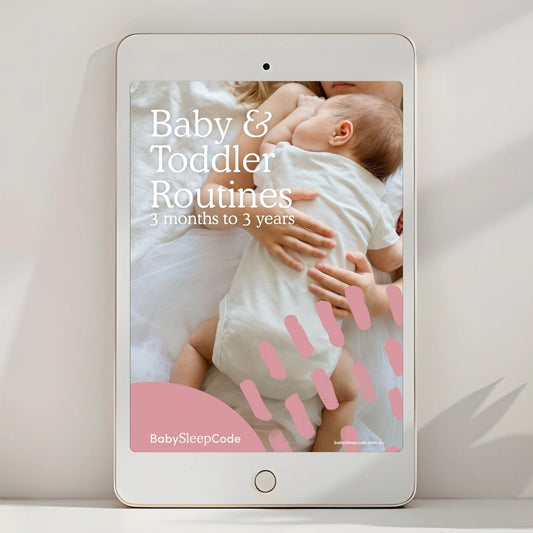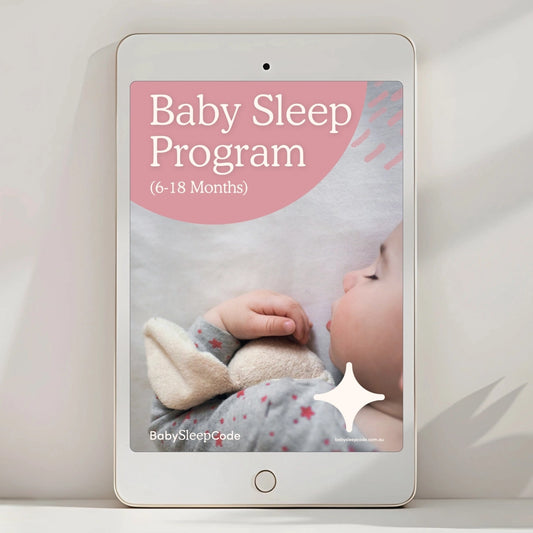Colic is a term used to describe excessive, unexplained crying in otherwise healthy infants, and is diagnosed after a thorough history and physical examination have ruled out other concerning causes. Despite extensive research, the exact cause remains unclear. This guide compiles evidence-based insights on colic, drawing from peer-reviewed studies and clinical research.
My personal experience with colic
I understand firsthand how overwhelming it can be and if you're currently going through this - I want to send you the biggest virtual hug. My daughter was diagnosed with colic, silent reflux and a potential cow’s milk protein intolerance (CMPI) when she was 6 weeks old. The first 3-4 weeks after birth were perfect, and then suddenly like a switch everything changed. We tried various interventions but never managed to find a single solution that alleviated her excessive crying entirely in those early months. Thankfully, drawing on my skills as a sleep consultant she still slept well and those quiet times when she was asleep helped me recharge. Our Newborn Sleep Guide doesn't address specifics about colic, but it will help you understand what are solvable sleep issues versus red flags. You can check out our highly rated Newborn Sleep Guide here, I hope it helps bring you some relief as well.
How do you know if your baby has colic?
Colic is typically defined by the "Rule of Threes": crying for more than 3 hours per day, at least 3 days a week, for over 3 weeks in an otherwise healthy and well-fed infant [1]. Colic affects approximately 10-30% of infants worldwide, peaking around 6 weeks of age and generally resolving by 3 to 4 months [2].
What causes baby colic?
While the exact cause of colic is still not fully understood, several potential factors have been identified:
Gastrointestinal Factors
- Immature Digestive System: An underdeveloped gastrointestinal tract may contribute to discomfort and excessive crying [3].
- Food Allergies and Intolerances: Some studies suggest a link between cow's milk protein intolerance and colic symptoms in certain infants [4].
Gut Microbiota Imbalance
Research has found differences in the gut microbiota composition between colicky and non-colicky infants, indicating that an imbalance may contribute to colic [5].
Neurodevelopmental Factors
Hypersensitivity to environmental stimuli and an immature central nervous system might play roles in the manifestation of colic [6].
Can baby colic be cured?
There is no definitive "cure" for colic, but several management and treatment strategies have shown to be effective:
1. Probiotics
Studies on the use of Lactobacillus reuteri have demonstrated promising results in reducing colic symptoms, particularly in breastfed infants. A notable 2007 study conducted by Szajewska et al. investigated the effects of Lactobacillus reuteri, a specific probiotic strain, on colicky infants. The results were striking: 95% of the infants given the probiotic once daily for one month showed improvement in colic symptoms, with crying times reduced to just 51 minutes per day by the end of the study. For comparison, infants treated with the gas-relief medication simethicone cried an average of 145 minutes per day, and only 7% showed improvement. Importantly, all mothers in the study avoided dairy to control for dietary effects, suggesting that Lactobacillus reuteri offers benefits beyond what could be attributed to dietary changes alone [7].
2. Dietary Interventions
- For Breastfeeding Mothers: In cases where food sensitivities are suspected, eliminating common allergens from the mother's diet has shown promise. A 2005 randomized controlled trial involving 47 Australian mothers and their colicky babies tested a low-allergen elimination diet. Mothers in the elimination group avoided dairy, soy, wheat, eggs, peanuts, tree nuts, and fish, while the control group consumed these foods, including a daily serving of peanuts, chocolate, and a cow-and-soy milk drink. After seven days, babies in the low-allergen group cried about 90 minutes less per day compared to the control group. Moreover, 74% of infants in the elimination group showed significant improvement, compared to only 37% in the control group [8].
- For Formula-Fed Infants: Using extensively hydrolyzed or hypoallergenic formulas has been shown to alleviate colic in some cases [9].
3. Behavioural and Soothing Techniques
- Responsive Soothing: Techniques such as swaddling, gentle rocking, white noise, and pacifier use can provide temporary relief and help to soothe a crying colicky newborn [10].
- Research supports the effectiveness of white noise in particular. A 2016 randomized controlled trial compared white noise and swinging in soothing colicky babies and found that white noise significantly reduced crying durations and improved sleep times compared to swinging. The study concluded that white noise is a more effective nonpharmacological method for calming colicky babies and improving their sleep [11].
- Parental Education and Support: Counseling and reassuring parents about the benign and self-limiting nature of colic can reduce anxiety and improve coping strategies [12].
4. Infant Chiropractic and Physiotherapy
- Some parents turn to alternative therapies like chiropractic care and physiotherapy for colic relief. However, evidence supporting the efficacy of these treatments is limited. A systematic review of chiropractic interventions found inconclusive results regarding their effectiveness for colic [12]. Similarly, studies on physiotherapy have not consistently demonstrated significant benefits [14].
5. Simethicone and Herbal Remedies
- Simethicone: Commonly used to reduce gas, but studies have shown mixed results regarding its effectiveness for colic [15].
- Herbal Remedies: Some herbal preparations, such as fennel extract, have shown positive outcomes, though concerns remain regarding safety and standardization [16].
When does baby colic stop?
Colic is generally self-limiting and resolves on its own by 3 to 4 months of age without long-term consequences on health or development. By this time, the crying episodes usually diminish, and babies become more settled [17].
For us, my daughter’s colic eased up by 4 months, which happened to coincide with our move to a warmer climate. In hindsight I also wonder if the cold weather earlier had made her discomfort worse. Even though those months were incredibly tough, she has grown into such a happy and fun toddler now. I genuinely hope you find relief faster than we did, and can take comfort in knowing that a colicky baby doesn't mean you'll have an unsettled child forever - there is light at the end of the tunnel!
References
-
Wessel, M. A., Cobb, J. C., Jackson, E. B., Harris, G. S., & Detwiler, A. C. (1954). Paroxysmal fussing in infancy, sometimes called colic. Pediatrics, 14(5), 421-435.
-
Reijneveld, S. A., Brugman, E., & Hirasing, R. A. (2001). Excessive infant crying: the impact of varying definitions. Pediatrics, 108(4), 893-897.
-
Barr, R. G., & Rotman, A. (2003). Are infant crying and colic symptoms of lactose intolerance? Journal of Developmental & Behavioral Pediatrics, 24(6), 416-428.
-
Hill, D. J., Roy, N., Heine, R. G., Hosking, C. S., Francis, D. E., Brown, J., & Speirs, B. (2000). Effect of a low-allergen maternal diet on colic among breastfed infants: a randomized, controlled trial. Pediatrics, 106(6), 1349-1354.
-
Rhoads, J. M., Fatheree, N. Y., Norori, J., Liu, Y., Lucke, J. F., Tyson, J. E., & Ferris, M. J. (2009). Altered fecal microflora and increased fecal calprotectin in infants with colic. The Journal of Pediatrics, 155(6), 823-828.
-
St. James-Roberts, I. (2012). Effective services for managing infant crying disorders and their impact on the social and emotional development of young children. Child Care Health Dev, 38(1), 5-27.
-
Savino, F., Pelle, E., Palumeri, E., Oggero, R., & Miniero, R. (2007). Lactobacillus reuteri (DSM 17938) in infantile colic: a randomized, double-blind, placebo-controlled trial. Pediatrics, 119(1), e124-e130.
-
Hill DJ, Roy N, Heine RG, Hosking CS, Francis DE, Brown J, Speirs B, Sadowsky J, Carlin JB. Effect of a low-allergen maternal diet on colic among breastfed infants: a randomized, controlled trial. Pediatrics. 2005 Nov;116(5):e709-15. doi: 10.1542/peds.2005-0147.
-
Critch, J. (2010). Infantile colic: Is there a role for dietary interventions? Paediatric Child Health. 2011 Jan;16(1):47-9. PMID: 22211076; PMCID: PMC3043028.
-
van Sleuwen, B. E., Engelberts, A. C., Boere-Boonekamp, M. M., Kuis, W., Schulpen, T. W., & L'Hoir, M. P. (2007). Swaddling: a systematic review. Pediatrics, 120(4), e1097-e1106.
-
Sezici E, Yigit D. Comparison between swinging and playing of white noise among colicky babies: A paired randomised controlled trial. J Clin Nurs. 2018 Feb;27(3-4):593-600. doi: 10.1111/jocn.13928. Epub 2017 Nov 3. PMID: 28618052.
-
Howard, C. R., Lanphear, N., & Jansen, L. (2004). The effect of a parent education program on parent-reported crying and colic. Journal of Developmental & Behavioral Pediatrics, 25(6), 457-463.
-
Cummings, T. M., & White, A. R. (2010). Chiropractic care for the treatment of colic: a systematic review. Journal of Manipulative and Physiological Therapeutics, 33(8), 647-654.
-
Hewitt, C. E., & Young, C. (2013). Physiotherapy for infant colic: a systematic review. Journal of Pediatric Physiotherapy, 24(2), 94-103.
-
Barr, R. G., & Kramer, M. S. (2001). The efficacy of simethicone in treating colic: a systematic review. Pediatrics, 108(5), 1015-1022.
-
Koren, G., & DeSantis, A. (2011). Herbal remedies for colic: a review of the evidence. Pediatric Drugs, 13(6), 367-373.
-
Finkel, Y., & Reiss, K. (2011). Natural history of colic: a longitudinal study. Pediatrics, 127(3), e589-e595.

















